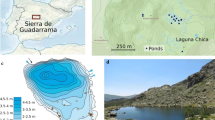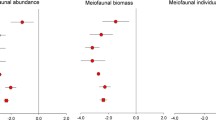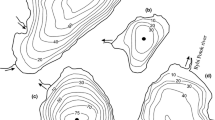Abstract
Among the topics covered by Hutchinson’s Santa Rosalia article, the question of the shortening and lengthening of food webs occupies a central role. As Hutchinson realized, at the time scales of ecological studies, the impact of invader species on established food webs is the fastest shortcut to the shortening or lengthening of the food webs. The construction of thousands of dams in Spain during the last century has offered ecologists a good opportunity to test the effects of invader fish species on the plankton dynamics of these systems. In this article, a series of data related to the food web structure of Sau Reservoir is analyzed for the period 1997–2005. Parameters such as Secchi depth and chlorophyll concentration, as well as abundance and size structure of zooplankton, have been matched to the zooplankton dynamics in the reservoir. Most of the changes detected within this period are attributed to the introduction of zooplanktivorous fish in the reservoir. The Secchi depth measurements have showed a progressive diminution in the clear-water phase during recent years. These changes have been related to the decrease in the abundance of Daphnia and to the reduction of the size of zooplankton, which help to explain concomitant increases in the chlorophyll concentration in the same period. Other observed changes in the composition of the zooplankton community have been the substitution of Daphnia by Bosmina and the increase in the abundance of rotifers. Thus, the annual average abundance of Bosmina in 1997 was 70% of cladocerans, while in 2005 it reached 98%. In parallel, the percentage occurrence of individual rotifers was 40% of total zooplankton numbers but had risen to 85% at the end of the period. All these changes are attributed to the artificial expansion of the food web through stocking of the reservoir with zooplanktivorous fish (Rutilus rutilus and Alburnus alburnus). This study improves our understanding of the trophic relationships in the food web prior to the introduction of the fish.







Similar content being viewed by others
References
Angeler, D. G., M. Álvarez-Cobelas, S. Sánchez-Carrillo & M. A. Rodrigo, 2002. Assessment of exotic fish impacts on water and zooplankton in a degraded semi-arid floodplain wetland. Aquatic Sciences 64: 76–78.
APHA (American Public Health Association), 1992. Standard Methods for the Examination of Water and Wastewater, 18th ed. American Public Health Association, Washington, DC: 991 pp.
Armengol, J., 1978. Zooplankton crustaceans in Spanish reservoirs. Verhandlungen, Internationale der Vereinigung Theoretische und Angewandte Limnologie 20: 1652–1656.
Armengol, J., M. Crespo, J. A. Morgui & A. Vidal, 1986. Phosphorus budgets and forms of phosphorus in the Sau Reservoir sediment: an interpretation of the limnological record. Hydrobologia 143: 331–336.
Armengol, J., J. C. Garcia, M. Comerma, M. Romero, J. Dolz, M. Roura, B. P. Han, A. Vidal & K. Simek, 1999. Longitudinal Processes in canyon type reservoirs: the case of Sau (N. E. Spain). In Tundisi, J. G. & M. Straskraba (eds), Theoretical Reservoir Ecology and its Applications. International Institute of Ecology, Brazilian Academy of Sciences and Backhuys Pub, Leiden, The Netherlands: 313–345.
Armengol, J., L. Caputo, M. Comerma, C. Feijó, J. C. Garcia, R. Marcé, E. Navarro & J. Ordóñez, 2003. Sau Reservoir’s light climate: relationships between Secchi depth and light extinction coefficient. Limnetica 22: 195–210.
Benndorf, J., W. Böing, J. Koop & I. Neubauer, 2002. Top-down control of phytoplankton: the role of time scale, lake depth and trophic state. Freshwater Biology 47: 2282–2295.
Bottrell, H. H., A. Duncan, M. Z. Gliwicz, A. Grygierek, A. Herzic, A. Hillbricht-Ilkowska, H. Kurasawa, P. Larsson & T. Weglenska, 1976. A review of some problems in zooplankton studies. Norwegian Journal of Zoology 24: 419–456.
Brooks, J. L. & S. L. Dodson, 1965. Predation, body size and composition of the plankton. Science 150: 28–35.
Carol, J., L. Benajem, C. Alcaraz, A. Vila-Gispert, L. Zamora, E. Navarro, J. Armengol & E. García-Berthou, 2006. The effects of limnological features on fish assemblages of 14 Spanish reservoirs. Ecology of Freshwater Fish 15: 66–77.
Carpenter, S. R. & J. F. Kitchell (eds), 1993. The Trophic Cascade in Lakes. Cambridge University Press, Cambridge: 399 pp.
Chase, J. M., 2003. Strong and weak trophic cascades along a productivity gradient. Oikos 101: 187–195.
Comerma, M., J. C. García, M. Romero, J. Armengol & K. Simek, 2003. Carbon flow dynamics in the pelagic community of the Sau Reservoir (Catalonia, NE Spain). Hydrobiologia 504: 87–98.
de Manuel, J., 2000. The rotifers of Spanish reservoirs: ecological, systematical and zoogeographical remarks. Limnetica 19: 91–167.
Dumont, J. H., I. Van de Velde & S. Dumont, 1975. The dry weight estimate of biomass in a selection of Cladocera, Copepoda and Rotifera from the plankton, periphyton and benthos of continental waters. Oecologia 19: 75–97.
Elton, C. S., 1958. The Ecology of Invasions by Animals and Plants. Methuen Ltd, London: 159 pp.
Feijoó, C., M. Comerma, R. Marcé, J. C. García, D. Balayla, E. Navarro & J. Armengol, 2008. Influence of phosphorus and irradiance on phytoplanktonic chlorophyll-a concentration and phosphorus contents at a diel scale in a Mediterranean reservoir. Limnetica 27: 329–342.
García-Berthou, E., 1999. Spatial heterogeneity in roach (Rutilus rutilus) diet among contrasting basins within a lake. Archiv für Hydrobiologie 146: 239–256.
Gilbert, J. J., 1988. Suppression of rotifer populations by Daphnia: a review of the evidence, the mechanisms, and the effects on zooplankton community structure. Limnology and Oceanography 33: 1286–1303.
Gliwizc, Z. M., 1990. Food thresholds and body size in cladocerans. Nature 343: 638–640.
Gliwizc, Z. M. & M. J. Boavida, 1996. Clutch size and body size at first reproduction in Daphnia publicaria at different levels of food and predation. Journal of Plankton Research 18: 863–880.
Herzig, A., 1994. Predator-prey relationships within the pelagic community of Neusiedler See. Hydrobiologia 275(276): 81–96.
Hrbácěk, J., M. Dvořakova, V. Kořinek & L. Procházokova, 1961. Demonstration of the effect of the fish stock on the species composition of zooplankton and the intensity of metabolism of the whole plankton association. Verhandlungen, Internationale der Vereinigung Theoretische und Angewandte Limnologie XLV: 192–195.
Hutchinson, G. E., 1959. Homage to Santa Rosalia or why are there so many kinds of animals? The American Naturalist 93: 145–159.
Jeffrey, S. W. & G. F. Humphrey, 1975. New spectrophotometric equations for determining chlorophylls a, b, c1 and c2 in higher plants, algae and natural phytoplankton. Biochemie und Physiologie der Pflanzen 167: 191–194.
Kwang-Hyeon, C., T. Nagata & T. Nanazato, 2004. Direct and indirect impacts of predation by fish on the zooplankton community. An experimental analysis using tanks. Lymnology 5: 121–124.
Lampert, W., W. Fleckner, H. Rai & B. Taylor, 1986. Phytoplankton control by grazing zooplankton: a study on the spring clear-water phase. Lymnology and Oceanography 31: 478–490.
Legendre, P. & L. Legendre, 1998. Numerical Ecology. 2nd Ed. Developments in Ecological Modelling, Vol. 20. Elsevier, Amsterdam.
Luecke, C., M. J. Vanni, J. J. Magnuson, J. F. Kitchell & P. T. Jacobson, 1990. Seasonal regulation of Daphnia populations by planktivorous fish: Implications for the spring clear-water phase. Limnology and Oceanography 35: 1718–1733.
Malley, D. F., S. G. Lawrence, M. A. Maciver & J. Findlay, 1989. Range of variation in estimates of dry weight for planktonic Crustacea and Rotifera from temperate North American Lakes. Canadian Technical Report of Fisheries and Aquatic Sciences, 666, iv + 49 pp.
Marcé, R., M. Comerma, J. C. García & J. Armengol, 2004. A neuro-fuzzy modelling tool to estimate fluvial nutrient loads in watersheds under time-varying human impact. Limnology and Oceanography: Methods 2: 342–355.
Margalef, R., D. Planas, J. Armengol, A. Vidal, N. Prat, A. Gutset, J. Toja & Y. M. Estrada, 1976. Limnologia de los embalses Españoles. Dirección General de Obras Hidráulicas, Ministerio de Obras Publicas, Madrid.
McCauley, E., 1984. The estimation of the abundance and biomass of zooplankton in samples. In Downing, J. A. & F. H. Rigler (eds), A Manual on Methods for the Assessment of Secondary Productivity in Fresh Waters. Blackwell Scientific Publications, Oxford: 228–265.
Murphy, J. & J. P. Riley, 1962. A modified single solution method for the determination of phosphate in natural waters. Analytica Chimica Acta 27: 31–36.
O’Sullivan, P. E. & C. S. Reynolds (eds), 2005. The Lakes Handbook, Vol. 2. Lake Restoration and Rehabilitation. Blackwell Science Ltd, Oxford, UK: 560 pp.
Persson, A. & L. A. Hansson, 1999. Diet shift in fish following competitive release. Canadian Journal of Fisheries and Aquatic Sciences 56: 70–78.
Politou, C.-Y., P. S. Economidis & A. I. Sinis, 1993. Feeding biology of bleak, Alburnus alburnus, in Lake Koronia, northern Greece. Journal of Fish Biology 43: 33–43.
Reynolds, C. S., 1984. The Ecology of Freshwater Phytoplankton. Cambridge Univ. Press, Cambridge: 384 pp.
Ruttner-Kolisko, A., 1977. Suggestions for biomass calculations of plankton rotifers. Archiv für Hydrobiologie, Ergebnisse der Limnologie 8: 71–76.
Scheffer, M., S. Rinaldi, J. Huisman & F. J. Weissing, 2003. Why plankton communities have no equilibrium: solutions to the paradox. Hydrobiologia 491: 9–18.
Sokal, R. & F. Rolf, 1995. Biometry. W. H. Freeman and Company, San Francisco: 859 pp.
Sommer, U., Z. M. Gliwicz, W. Lampert & A. Duncan, 1986. PEG-model of Seasonal Succession of Planktonic Events in Fresh Waters. Archiv für Hydrobiologie 106: 433–471.
Steiner, C. F., 2004. Daphnia dominance and zooplankton community structure in fishless ponds. Journal of Plankton Research 26: 799–810.
Stemberger, R. S. & E. K. Miller, 2003. Cladoceran body length and Secchi disk transparency in north-eastern U.S. lakes. Canadian Journal of Fisheries and Aquatic Sciences 60: 1477–1486.
Thornton, K. W., B. L. Kimmel & F. E. Payne (eds), 1990. Reservoir Limnology: Ecological Perspectives. John Wiley & Sons, Inc, Somerset, NJ: 246 pp.
Vašek, M., J. Kubečka & J. Sedă, 2003. Cyprinid predation on zooplankton along the longitudinal profile of a canyon-shaped reservoir. Archiv für Hydrobiologie 156: 535–550.
Vidal, A. & J. Om, 1993. The eutrophication process in Sau Reservoir (NE Spain): a long term study. Verhandlungen, Internationale der Vereinigung Theoretische und Angewandte Limnologie 25: 1247–1256.
Vinni, M., J. Horppila, M. Olin, J. Ruuhijärvi & K. Nyberg, 2000. The food, growth and abundance of five co-existing cyprinids in lake basins of different morphometry and water quality. Aquatic Ecology 34: 421–431.
Wright, D. I. & J. Shapiro, 1984. Nutrient reduction by biomanipulation: an unexpected phenomenon and its possible cause. Verhandlungen, Internationale der Vereinigung Theoretische und Angewandte Limnologie 22: 518–527.
Acknowledgments
The Spanish Government (projects CGL2004-05503-C02-01 and CGL2008-06377-C02-01) provided financial support for this study. We thank everyone involved in field work of Sau Reservoir and ATLL Water Supply Company for funding the long-term monitoring program. We thank comments from two anonymous reviewers that greatly improved the quality of this article.
Author information
Authors and Affiliations
Corresponding author
Additional information
Guest editors: L. Naselli-Flores & G. Rossetti / Fifty years after the “Homage to Santa Rosalia”: Old and new paradigms on biodiversity in aquatic ecosystems
Rights and permissions
About this article
Cite this article
Ordóñez, J., Armengol, J., Moreno-Ostos, E. et al. On non-Eltonian methods of hunting Cladocera, or impacts of the introduction of planktivorous fish on zooplankton composition and clear-water phase occurrence in a Mediterranean reservoir. Hydrobiologia 653, 119–129 (2010). https://doi.org/10.1007/s10750-010-0348-y
Published:
Issue Date:
DOI: https://doi.org/10.1007/s10750-010-0348-y




